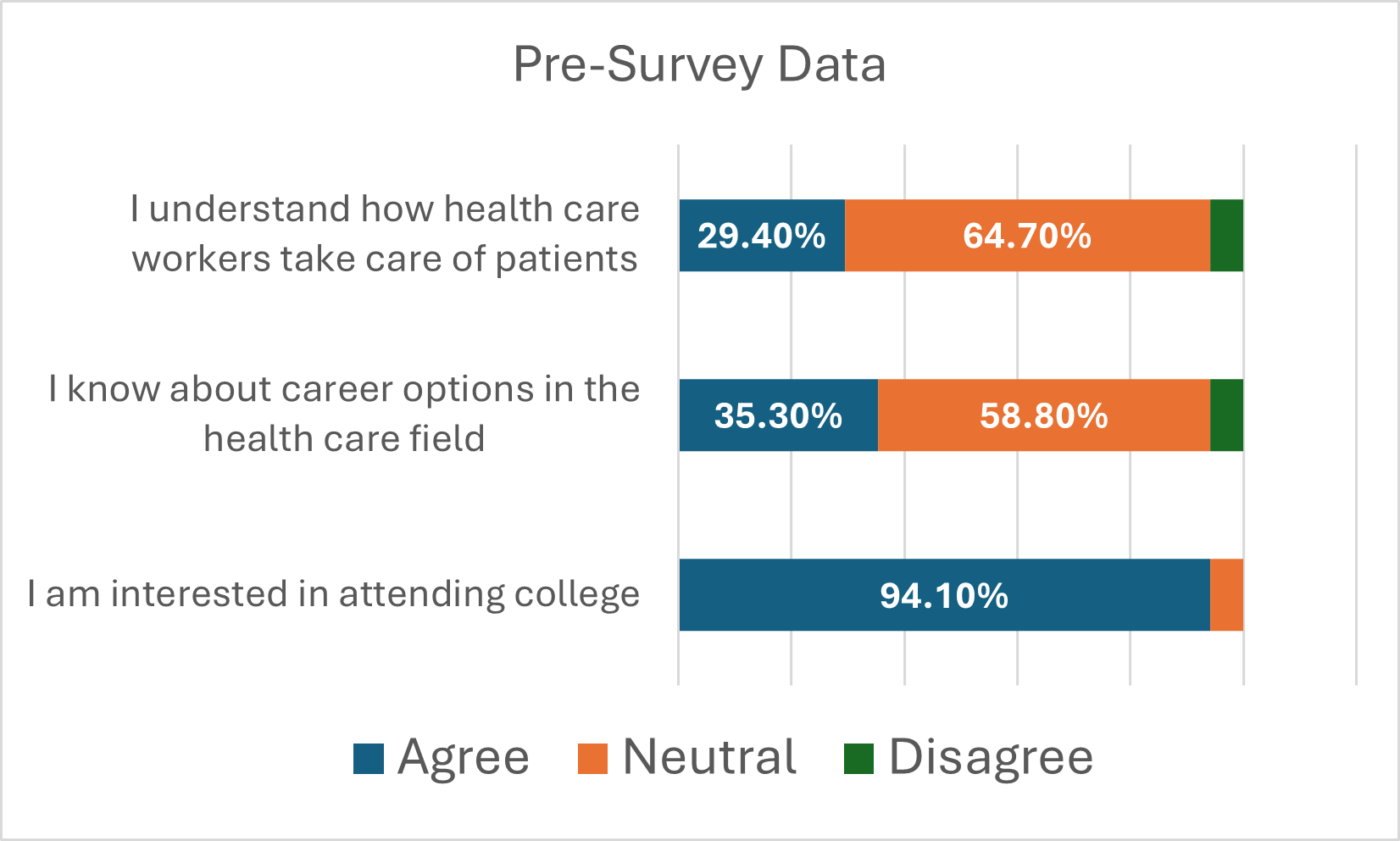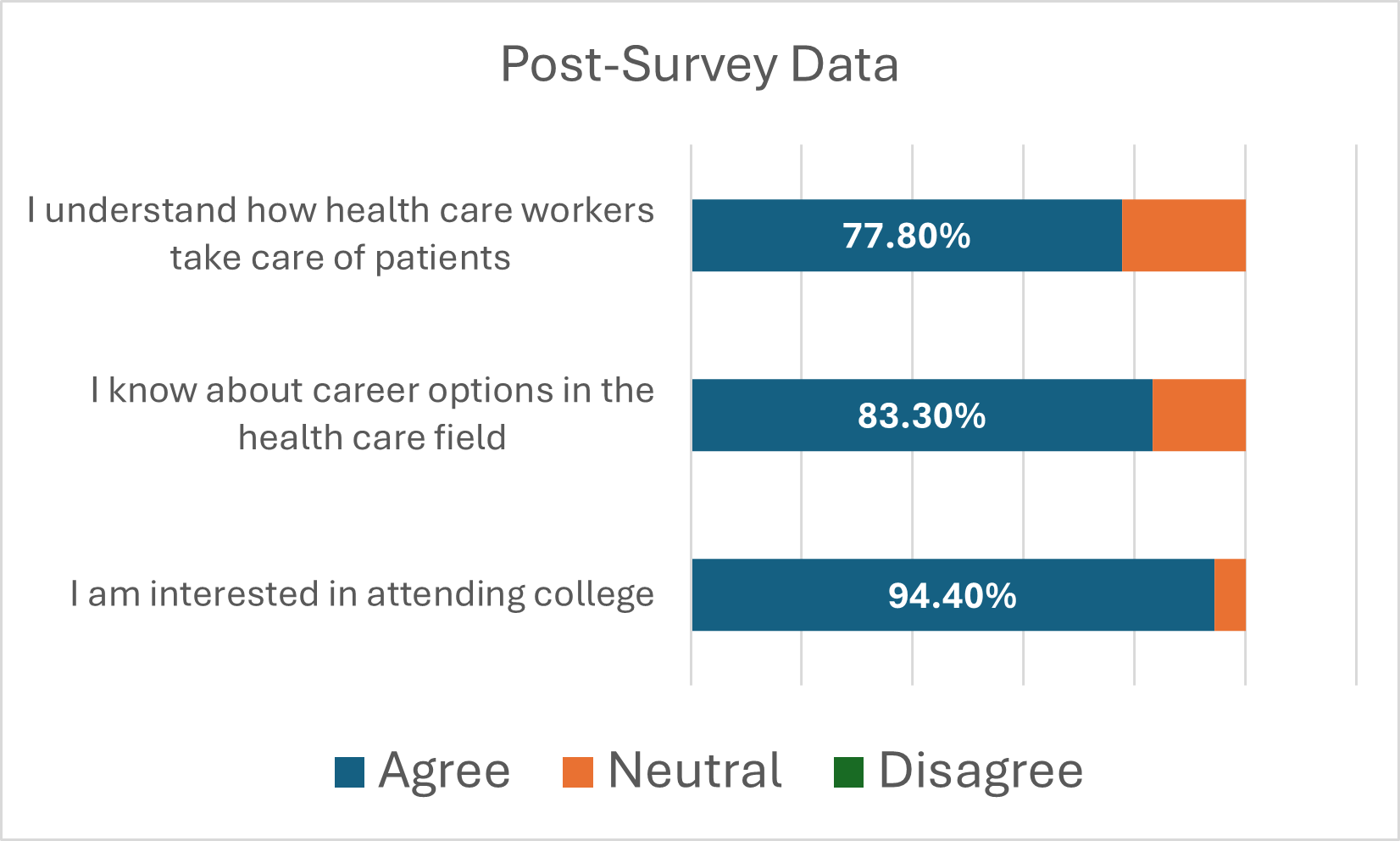As we head back to school, I’m reflecting on this spring’s season of graduation; my daughter recently had a high school cap and gown photo shoot holding her 4-year-old kindergarten graduation picture. We reminisced about childhood play and future career aspirations, including memories of wanting to be a doctor, nurse, or dentist when growing up. As her mother and a nurse, I provided guidance and support for that dream of a career in healthcare.
These memories stimulated questions about engaging more youth to consider a career in healthcare. For those who do not have family members in healthcare for exposure and guidance, how do they learn about these opportunities? What is the best age or grade to connect with them and guide them on a path to success? How will early engagement impact the nursing and overall healthcare workforce of the future?
The NPD’s Role
The healthcare workforce is anticipating increased retirement and decreased recruitment, and will need a diverse and well-prepared generation to impact the nation’s growing needs (National Academies of Sciences, Engineering, and Medicine, 2021). Programs aimed at introducing underrepresented racial and ethnic youth to healthcare careers, particularly in middle and high school years, have been implemented to recruit this next generation (Bryant & Lee, 2023; Quan et al., 2022; Randolph & Mattey, 2023). How does that impact patient outcomes? Gefter et al. (2018) reported that “[b]ecause minority medical professionals are more likely to return to their home communities and practice in underserved communities, their entry into health professions directly impacts access to and satisfaction with care for racial and ethnic minority populations” (p. 701).
Nursing professional development practitioners (NPDPs) perform environmental scanning and help develop visionary and novel approaches to ensure we have a diverse, engaged, prepared, and supported workforce. NPDPs are in a unique position to form collaborative partnerships with leaders and community-interested parties. We create allyships and strong relationships with others (More, 2023). These collaborative partnerships can impact and address workforce challenges.
Creating HERO Camp
In 2023, PEARLS for Teen Girls reached out to Aurora Sinai Medical Center to inquire about developing an event for teen girls to learn about healthcare occupations. The nonprofit organization, focused on middle and high school girls, provides positive role models and empowers girls to identify resources to develop and build skills leading to their version of success. The organization’s values—Personal responsibility, Empathy, Awareness, Respect, Leadership, and Support (PEARLS)—guide activities that promote self-development, self-esteem, healthy relationships, social-emotional learning, community participation, and college and career readiness (PEARLS for Teen Girls, 2024).
Acting as consultants and leaders, NPDPs create collaborative partnerships and impact role development. This was a unique opportunity to leverage these NPD roles and partner with internal and external colleagues. Our NPD team met with our internal partner, a volunteer services manager, to gain buy-in and support. Responsibilities and action items were identified by this group. The next step was to create a theme.
References to doctors and nurses being “healthcare heroes” are common. We wanted to create a theme that highlighted not only nurses but other healthcare heroes as well. And thus, our theme was born—HERO: Healthcare Explorers Reaching Occupations.
The NPD team engaged interdisciplinary clinical partners from nursing, pharmacy, laboratory, respiratory therapy, imaging services, and rehabilitation services including speech therapy, physical therapy, and occupational therapy to participate in HERO Camp. The NPDPs met with a presenter from each discipline to strategize on interactive strategies and gamification activities. The learning styles of children as well as age, interest, and technology capabilities were considered. All collaborated to create engaging, visual, and hands-on activities that the students would rotate through.
Seventeen eighth- and ninth-grade students and two adult chaperones participated in the three-hour HERO Camps event. A brief introduction provided an overview of why to choose a career in healthcare, 10 potential careers, and information on education and training. Next, the girls were divided into superhero-themed groups: Lightning Luminaries, Magnificent Magnetics, and Kinetic Crusaders, where they rotated every 20 minutes through the six groups of healthcare superhero stations. The hospital teammates inspired this next generation by sharing their own journey to their profession and the education and training involved. During the laboratory station, presenters provided the girls with white coats and microscope viewers of slides used for education. Respiratory therapy brought a mannikin and coached the girls on intubation. A forensic nurse demonstrated the use of evidence kits and had the girls take a hands-on approach in securing the kits and labeling. A superhero photo booth and optional art coloring project were available during breaks and scheduled down-time rotations. A goodie bag was provided at the end with small items.
Outcomes: Fostering Future Heros
The girls and their chaperones were bustling with enthusiasm by the end of the day with all they had learned. Facilitators and presenters overheard comments from participants on how this event solidified an interest as a future healthcare hero. Feedback from the PEARLS organization was received after the event: "Thank you! The girls really enjoyed it. I've heard that this Aurora visit has been the best field trip so far—so thank you to you and your team for making this happen."
We measured the success of this program first by understanding if this influenced the youth’s decision to consider college, second to improve their awareness of different career options in the healthcare field, and third to enhance their understanding of how healthcare workers take care of patients. We provided the students with a pre- and post-survey. Eleven eighth-grade girls and six ninth-grade girls responded to the pre-survey. One additional girl responded to the post-survey but did not answer the grade level. The following graph shows the results of the pre-and post-surveys, where the students indicated their level of agreement with three statements.


Lessons Learned and Implications
While we had sent the community organization director a link to the QR code pre-survey, we did not have any participation prior to the event. We had paper copies available and were able to engage the girls in that route. Having the paper survey also gave us insight into the writing skills of this age group and led us to reconsider partnering with our organization’s health literacy team to modify surveys for future events.
Two additional questions added to the post-survey were:
- What other healthcare careers would you like to learn about?
- What did you like about today and what can we improve on or do differently if we offer this again?
4 respondents mentioned psychology, trauma, and crime evidence as topics they would like to learn more about. We are unclear if the forensic nurse or their lived experience impacted this response. This highlights an awareness of trauma and violence, and we would like to dive deeper into how we can help build the resilience and well-being of our youth and address the social determinants of health.
The final question received overwhelmingly positive feedback, with comments highlighting the value of learning about different healthcare professions and understanding how each role contributes to patient care.
Unanticipated events that we will consider in the future include bus delays, photo consents in advance for minors, having adequate time to transition between the rotations, and coordinating breaks around normally scheduled school mealtimes.
Future Plans
We desire to scale this event and tailor to both urban and rural youth in our respective markets. We are partnering with leadership to submit grant applications, secure funding, and garner additional resources to provide future HERO camps. Collaborative outreach with volunteer services, talent acquisition, community outreach leadership, local high schools, student organizations, and other nonprofit agencies began after the first HERO camp. A second camp is planned for early fall 2024 with 30 ninth- and tenth-grade boys from the Black and Latino Male Achievement program through the local public school system. The next camp will include presentations by surgical services and simulation. While there is no current method to track participants after they leave the camp, opportunities exist for long-term follow-up as we continue to build and strengthen the collaborative partnership between youth organizations and the healthcare enterprise.
References
- Bryant, K., & Lee, A. (2023). Creating a pathway to health-care professions for historically marginalized students. Creative Nursing, 29(4), 389-394. https://doi.org/10.1177/10784535231212474
- Gefter, L., Spahr, J., Gruber, J., Ross, S., Watson, L., & Mann, B. (2018). Addressing health disparities with school-based outreach: The healthcareer academy program. Journal of Racial and Ethnic Health Disparities, 5(4), 700-711. https://doi.org/10.1007/s40615-017-0414-5
- More, L. (2023). Nursing professional development practitioners' responsibility for collaborative partnerships. In M. Harper (Ed.), Core curriculum for nursing professional development (6th ed., pp. 392-405). Association for Nursing Professional Development.
- National Academies of Sciences, Engineering, and Medicine. (2021). The future of nursing 2020-2030: Charting a path to achieve health equity. https://doi.org/10.17226/25982
- PEARLS for Teen Girls. (2024). PEARLS for teen girls. Retrieved April 12, 2024, from https://www.pearlsforteengirls.com/home
- Quan, I. L., Sriram, N., Lam, E., Jain, R., Boadi, N., Singh, A., Velasco, V., O’Brian, C. A., Post, S. L., & Simon, M. A. (2022). Project MED (Medicine, exposure, and development): Promoting access to healthcare education for historically underrepresented groups through community engagement, sustainability, and technology. Clinical Obstetrics & Gynecology, 66(1), 4-13. https://doi.org/10.1097/grf.0000000000000743
- Randolph, A., & Mattey, B. (2023). Moving upstream to address health inequity: A middle school program to introduce students to a career in nursing. NASN School Nurse, 38(1), 33-39. https://doi.org/10.1177/1942602x221133125
Katherine Leistico, MS, BSN, RN, NPD-BC
Nursing Professional Development Specialist, Advocate Health
Leistico has over 26 years of nursing experience and is currently a system site nursing professional development specialist at Advocate Health. She has a passion for role development and creating collaborative relationships to elevate nursing practice and promote professional growth. Kathy holds a master’s degree in leadership and is certified in nursing professional development.
Mandy Walter, MSN, RN, NPDA-BC, WHNP-BC
Nursing Professional Development Specialist, Advocate Health
Walter has a passion for the transition to practice period and creative facilitation strategies. She obtained her certification for professional achievement in advanced nursing professional development in January of 2024. Walter published her first article in the Journal for Nurses in Professional Development in March 2024, “Quality Improvement Project to Standardize a Nurse Extern Program Across a Multistate Health System.” She enjoys learning innovative technology and is the webmaster for the Midwest ANPD affiliate.